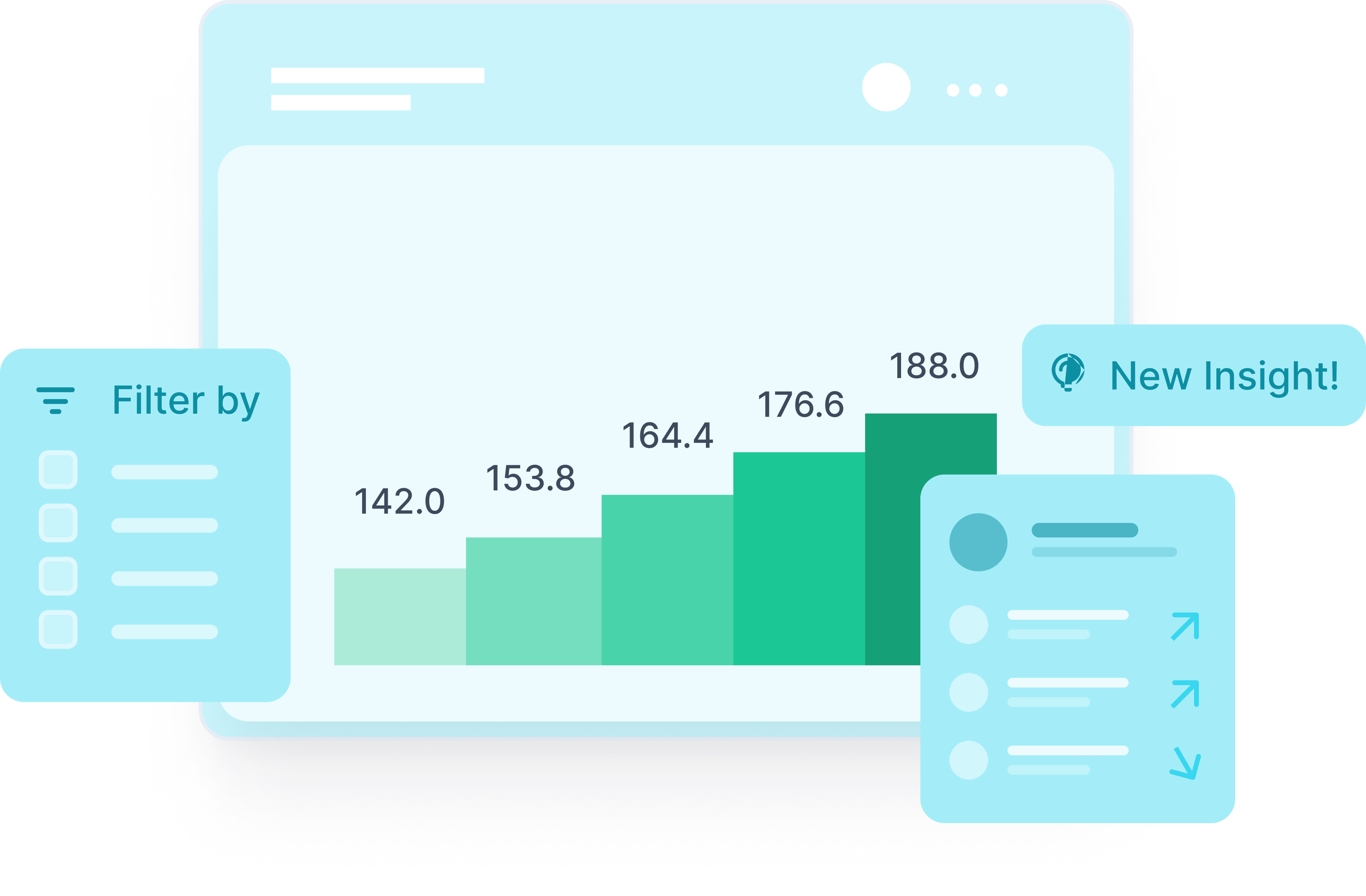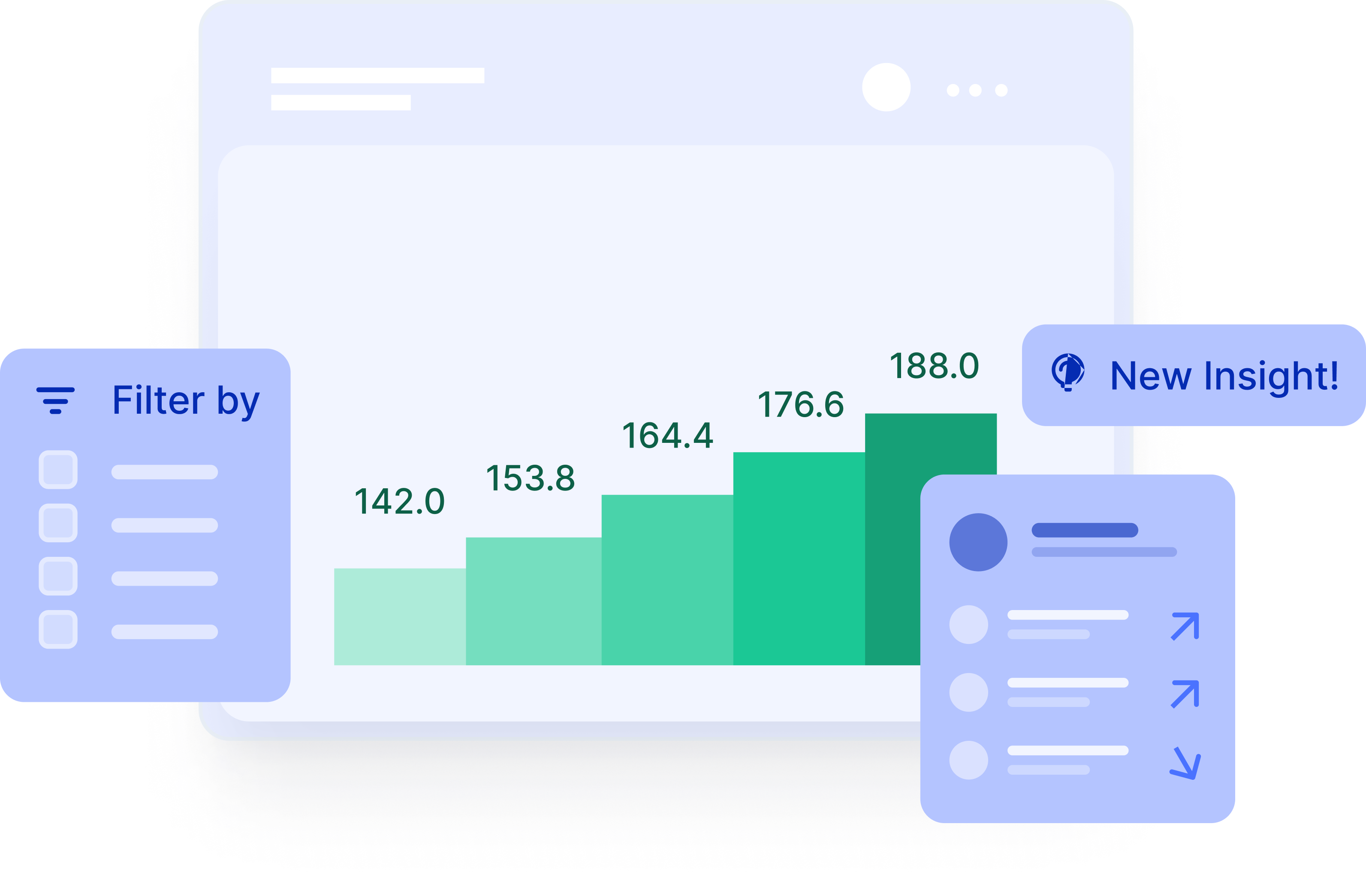How Revenue Analysis Can Help your Bottom Line

Co-Founder & CEO
Now more than ever, revenue analysis plays a pivotal role in enabling companies to make smart data-driven decisions about their go-to-market (GTM) strategy across every stage of the funnel. This is especially true when it comes to SaaS vendors, their unique lead to renewal pipeline, and their prospects for long-term success. The process comes down to identifying what works and what doesn’t in your GTM plans, and where and how you can optimize them. In this guide, we’ll explore how to analyze your revenue flows in a way that supports and promotes efficient business growth.

What is revenue analysis?
Traditionally, companies thought of revenue in terms of pure sales. However, there are numerous business operations that contribute to sales, either directly or indirectly, including marketing and customer success. The revenue analysis approach takes this into consideration by extending a unified approach to revenue-generating operations across all teams and departments. In other words, it presents a paradigm shift from siloed analysis projects carried out by individual departments to a strategic analysis process focused on the end-to-end revenue stream. The term RevOps, or revenue operations, encompasses this broader business strategy.
The definition of revenue analysis is a comprehensive review of the revenue flows generated by all of the company’s business activities, complete with drill downs into every relevant department, product, region and customer segment. It covers both results that are specific to a certain point in time and trends that can be seen over time. For example, a revenue trend analysis report might look at factors such as which products are the most popular to customers coming from specific campaigns or at which time of year sales peak and fall in a specific customer segment. Equipped with these data-driven insights, revenue leaders will be able to make informed and timely decisions as to their go-to-market motions.
Types of revenue analysis
The scope of revenue analysis is broad so there are different approaches to it based on various analysis types and roles. For example, a SaaS company might conduct a customer revenue growth analysis by tracking metrics such as the customer lifetime value (LTV) based on their lead source, while a retailer might find that a sales revenue analysis is more relevant since it looks at how sales of a specific product trend over a given timeframe.
Larger enterprises may want to break down their revenue according to multiple parameters simultaneously such as an analysis of revenue coming from products sold in a certain region, or coming from campaigns targeted at a specific customer segment. Other types include revenue analyses that concentrate on specific departments, such as digital marketing teams, customer success, or direct sales. A mature revenue analysis program will also consider trends over time by drawing on historical data to create accurate forecasts.
Why is revenue analysis important?
Revenue analysis is especially important in today’s economy in which businesses are focusing on revenue growth while keeping spending down. Not surprisingly, SaaS companies have been some of the earliest adopters of the RevOps approach to managing their revenue flows since it allows them to figure out how to optimize revenues by leveraging positive trends and fixing negative ones.
For SaaS vendors, growth isn’t defined only by the number of products sold, but by a complex sales and marketing funnel. It’s a business model that also involves people activating accounts and engaging with products and features after which, ideally, they become brand champions who will readily recommend the service to others. However, as the business grows, it becomes more and more difficult to optimize operations across multiple products, teams, regions and customer segments in order to ensure that the company reaches its goals. That’s where revenue analysis comes in.
The problem with the traditional approach to business growth is that it’s often siloed. In such an environment, different departments and regions exist in their own bubbles, using different numbers, tracking different metrics and focusing on different goals. Revenue analytics requires that teams across the entire revenue value chain align in terms of both KPIs and incentives so that they can work together in pursuit of company growth.
By bringing sales, marketing, and customer success teams together under a common goal, the revenue analysis strategy ensures a standardized, data-driven approach to decision making. To that end, it’s becoming an increasingly vital area that’s helping organizations recognize trends, determine optimal product or service mixes, forecast future market trends, and set ideal price points.
This ultimately means that decision-makers know how they can add value to the business, becoming faster and smarter in an era of constant, and often unpredictable, changes. This is especially relevant in our highly dynamic world where SaaS GTM motions are growing more and more complex across different teams, regions, products and target segments.
The benefits of revenue analysis
If done right, revenue analysis provides multiple benefits to the company as a whole, as well as to team members, but the three key ones are:
Determining business viability
Every business needs to be profitable in order to become sustainable, but it can also take a few years for high-growth startups to get to that point. Revenue analysis brings these facts into focus by helping you determine the viability of your current business model. If profitability, or potential profitability, is lacking, and there’s no sign of improvement based on the revenue data you currently have available, then it may be time to rethink your go-to-market motions or pivot your entire business model.
Planning for the future
Whether your business is a high-growth startup or an established enterprise, it’s vital that you leverage data-driven decision making to plan for a sustainable future. For startups, this means finding the right product fit and gaining a closer understanding of the ideal customer profile, the sales funnel and the customer journey. For established companies, a lot of it is about maintaining profitability and innovating rapidly to keep up with the competition. In both cases, revenue analysis provides a better idea of what to expect in the foreseeable future and, therefore, plan accordingly.
Knowing where, when and how to invest
Knowing where, when and how to invest is the holy grail of revenue analysis, since it is based on the knowledge of what’s working and what isn’t. Whether you’re selling products, subscription plans, or even individual product features, there are always certain aspects of the go-to-market plan that don’t perform as well as you had hoped. While there might be room for improvement in such cases, it’s important to know what not to pour your profits into. By helping you identify the most successful aspects of your business and its value proposition, you’ll know where to invest – whether it’s in improving your go-to-market strategies or improving your products and services.
The challenges of revenue analysis
Although there’s no denying the enormous value that a revenue analysis strategy brings to a business, there are still some challenges to overcome. First of all, RevOps is a relatively new concept that many business leaders are not yet familiar with. For established businesses, one of the first challenges to overcome might simply be a lack of buy-in from stakeholders.
The relevant people need to understand that RevOps ultimately presents a shift in corporate culture, rather than a specific product or type of technology. Before adopting a RevOps strategy, it’s important to ensure that the company already has a reasonably clear picture of the customer journey and has identified the necessary expertise required to accommodate that journey.
Revenue analysis is a core component of the broader RevOps strategy. Fortunately, it also addresses some preexisting challenges that come with relying on conventional business intelligence tools which are highly resource- and time-consuming, especially when data is integrated from many different sources. This is true both during the system’s setup process which can take many months to complete, and during the ongoing work where data analysts need to address numerous business questions coming at them from across the company. Since this involves a lot of manual work, it typically results in significant delays where the answers sometimes arrive after it’s too late to change the company’s GTM strategy.
Automated revenue analysis isn’t meant to completely replace traditional BI, but it does equip sales, marketing and customer success teams with the immediate data-driven insights that have a direct impact on their roles. Automating the process allows them to quickly become more effective by easily identifying and removing bottlenecks in their GTM motions, as well as leverage positive revenue trends in a timely manner.
There’s a marked improvement in decision-making processes, especially when revenue leaders are empowered to run their own analysis on the data, reaching the same results far quicker and without requiring the assistance of data analysts. Adding this autonomy of analysis and democratization of the data role leads directly to being able to optimize performance and reach revenue growth goals much more quickly and efficiently.
Pre-built GTM templates and metrics

How to conduct revenue analysis
As a fundamental component of RevOps, revenue analysis must start with leadership, whether the CEO, CRO or COO working through the VP or Director of RevOps. Getting the support of stakeholders is an essential part of the process, since sales, marketing, finance and customer experience teams need to work together in pursuit of a common goal.
Here are the five fundamental practical steps that need to be taken when conducting revenue analysis as part of building a RevOps culture:
Data collection
Analysis depends on data, so the obvious first step is to get your revenue data in order. Chances are you’re probably collecting a lot of the right data already but it’s likely across multiple systems that span sales, marketing, customer success, finance and more. The problem is that the data is not always clean due to a variety of issues including input errors, alignment discrepancies, missing data and field anomalies. For accurate and consistent results, it’s important to go through an orderly data hygiene process which ensures that the metrics accurately reflect the actual business picture.
Analysis
Knowing which data you need to track may be simple enough, but the real challenge lies in integrating all your revenue-related systems before you can start analyzing the data. An automated platform will typically allow you to connect almost any data source since this is necessary before it can start analyzing data for insights.
With integration and automation taken care of, you need to start analyzing massive amounts of data using a variety of tools that can range from Excel to BI systems to automated revenue analysis tools. Equipped with visualized insights presented in the form of interactive charts and tables, you’ll be able to accurately answer key business questions such as who your best customers are for specific products, who is bringing in the most sales from particular market segments, and which products and services are performing best in certain regions.
This thorough analysis should result in actionable insights which clearly show what is working and what is not across the different revenue-related departments so that the company’s go-to-market motions can be tested and adjusted accordingly. With an automated system, this can be done almost in real-time to ensure that any time-sensitive issues (whether positive or negative).
Reporting
For proper revenue analysis your reports should be timely and accessible, containing insights that are relevant to their target audience. For example, sales and marketing teams will want to know how their various go-to-market motions are performing, while finance teams will primarily be interested in the hard financial figures.
While things like quarterly and yearly revenue reports continue to play an important role in any business, the increasingly dynamic nature of today’s market demands agility and timeliness. For example, sales and marketing teams often need to change course on a dime so they can capitalize on new opportunities they have identified or fix serious issues that they have discovered. Automated revenue analysis should allow you to compile these reports with little more than the click of a button, and get them on-demand whenever you need them.
Forecasting
Forecasting goes hand-in-hand with reporting by informing teams not only what they need to do now, but also what to expect in the foreseeable future. Because there are still many things in business that take time, sales and revenue forecasting are vital for making informed decisions about everything from go-to-market motions to marketing campaigns to sales staffing.
Revenue teams need to use forecasting models that fit their requirements based on industry-standard models in order to get the most accurate and relevant revenue forecasts for their particular needs. For example, the pipeline revenue forecasting model looks at the projected performance of the sales pipeline based on historical sales data and external factors like industry trends. Another approach is backlog revenue forecasting which forecasts revenue based on sales that have been committed but as yet not completed. This is especially valuable for B2B SaaS companies that deal with large contracts or for retail businesses where customers have ordered products that aren’t currently in stock.
Collaboration
In a mature RevOps environment, revenue analysis should span the entire revenue flow from sales to marketing to customer success to finance, and incentives should be aligned across the broader team. This requires that everyone has access to the same data, albeit with the ability to customize their reports and feeds to suit their specific goals and priorities. It’s important that every team has a tailored workspace that allows them to track the metrics that matter to them since, after all, being overwhelmed by data benefits no one.
A collaborative approach helps create an organization-wide culture of accountability in which everyone understands how their roles complement the roles of others. After ensuring better decision-making, companies need to swiftly propagate the actionable insights gained through the revenue analysis to the relevant team members - from the CEO down to the RevOps manager - so they can be implemented as soon as possible. This helps eliminate the glaring inefficiencies that come with the siloed approach of old. After all, much like the customer journey itself, the revenue pipeline spans multiple departments and operations, so it demands a unified approach.
Another crucial aspect of cross-company collaboration is determining a meeting cadence that is right for different teams and varying purposes. The cadence itself depends on the goal of each meeting - daily checks to make sure there are no serious issues, weekly funnel progression updates to the CRO, cross-departmental meetings to prepare for a quarterly business review with the CEO, or an end-of-year prep meeting to determine the ROI of various sales and marketing activities.
Bottom line (pun intended), revenue analysis is a must have!
By now, virtually every business leader understands that data is the fuel that drives growth through informed decision-making. The challenge, especially at data-heavy SaaS companies lies in making sense out of the constantly expanding big data footprint with efficient revenue growth as the goal. Fortunately, this is exactly what a thorough revenue analysis process achieves. Automated solutions make this process far quicker and easier, replacing the existing time- and resource-intensive tools.
Sightfull’s revenue analysis and optimization platform helps SaaS companies continuously drive efficient growth by enabling revenue leaders and revenue operations teams to quickly analyze, test and adjust their go-to-market strategies. They can easily investigate revenue trends at a highly granular level, identify their root causes, and act on proactive insights and alerts regarding time-sensitive business issues. By receiving immediate answers to all their business questions, Sightfull users gain a comprehensive understanding of their entire revenue cycle in a matter of days, without having to rely on overworked data analysts, resource-intensive BI systems or time-consuming processes.
Access revenue analysis templates

Frequently asked questions
What are the six approaches to revenue analysis?
Revenue analysis can be performed for a specific purpose or per department, product, customer segment or region. It can also be done for the purpose of forecasting or tracking revenue trends.
What metrics should be considered during revenue analysis for SaaS companies?
What is the goal of revenue analysis and optimization?
Provide full-funnel accountability and achieve closer alignment between sales, marketing, and service teams to enable data-driven decision-making, both strategic and tactical, in order to efficiently drive revenue growth.
What are the most important GTM questions that companies need to ask?
- Are our go-to-market plans financially viable?
- What’s working well, and what can we improve?
- What main business priorities should we focus on?
Talk to an expert
Learn how revenue analysis can help your bottom line
Streamline pipeline management
Improve your planning capabilities including capacity, headcount, account allocation, marketing spend and ICP segmentation, while continuously tracking actual results to evaluate the success of your sales strategies.